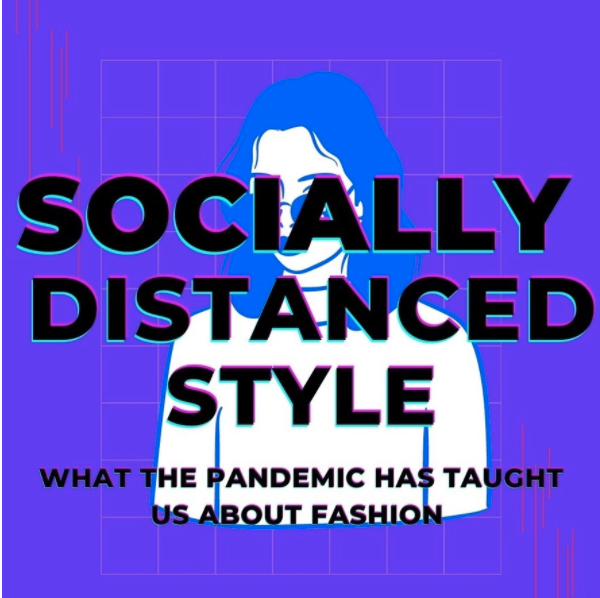Socially Distanced Style: What the Pandemic Has Taught Us About Fashion

Design by Joey Sigala
Image description: In bold black text with blue and red shadows reads: Socially Distanced Style: What the Pandemic Has Taught Us About Fashion. This is superimposed over a blue and white drawing of the torso and head of a person with shoulder length hair. They look over small circular sunglasses. All this is laid over a purple background with a lighter purple grid in the center and purple lines in the upper left corner.
How much has fashion really changed during the course of the pandemic? Although trends are constantly evolving, expanding, and repeating, there is a lack of systemic change in the fashion industry that leaks into fashion trends by proxy. Fashion continues to be an industry that carries on its origins of being made for and by the white and wealthy without ever acknowledging the harm it creates in communities of color or other less-represented groups. However, we are now witnessing shifts never before seen that are placing less emphasis on high-fashion yet maintaining the issues of high-fashion in the lower echelon of the industry. Historically, the high-fashion industry has lacked representation for darker skin complexions, body types of different sizes, and people who were not well connected to fashion executives. Moreover, the industry has been guilty of cultural appropriation more than a handful of times. The industry thus far has mostly catered to “white aristocrats, debutantes, and socialites.”
As economic tensions rise across America due to the pandemic, people are beginning to defy the long-established high-fashion trends associated with classism. They are now endorsing alternative fashion trends that don’t break the bank, causing people to believe widespread systemic change is happening across the fashion industry itself and the trends. Alternative fashion trends that have become more mainstream include 2000s fashion, punk, grunge, and brightly colored hair. The upsurge of alternative fashion has been especially popular on Tiktok and Instagram. This includes the prominence of the “little shirt big pants” trend and the increasing popularity of thrifting apps like Depop; it is the rise of the Y2K aesthetic and the downfall of skinny jeans. Underlying each of the trends is the heavy prominence of thrifted finds and vintage clothing to create the perfect ensembles. It appears as though it is becoming trendy to go against the long –– and I do mean long –– history of fashion being by and for the predominantly white bourgeoise.
As clothing straight from the racks becomes less popular and second-hand finds an increase in popularity, the fashion industry no longer has the power to continue solely catering to eurocentricity and wealth if it wants to persist in a society increasingly ready to call out racist and classist behavior. The pandemic seems to have created an entirely new perspective on fashion that is not just for those defined as the beauty standard. As a result, fashion journalists have gone as far as saying, “Fashion’s Racism and Classism Are Finally Out of Style.” Although shifts are definitely happening, fashion at large is still guilty of replicating the same industry trends of appropriation and inaccessibility. Statements proclaiming profound change seem a little premature, considering many of the original industry issues still exist but in smaller microcosms.
The new trends are not without fault. Whatever good they are doing, they appear to be simultaneously replicating the same past. Although the classism and racism in the latest trends are slightly more nuanced, it definitely still exists. For those who depend on thrifting as an affordable way to buy clothes, increased thrifting and reselling make second-hand shopping less accessible. Second-hand stores peaking in popularity has led to the gentrification of thrift shopping. Shops once made accessible to everyone are now catering to the wealthy once again by putting so-called good finds in small, curated boutiques at higher prices and leaving the rest of the clothes in regular shops while still raising prices.
Previously, the fashion industry had made things inaccessible with cost. It created an industry that tied being fashionable to having money and thus left anyone who could not fit the image of wealth feeling that they were never enough. It put everyone on a never-ending treadmill of trying to obtain the unobtainable, be it wealth or a series of hyper-specific beauty standards. Although shopping second-hand had already become extremely popular pre-pandemic, Covid has uniquely caused companies like ThredUp to experience a 31% browsing increase in May alone. With the increasing popularity of second-hand stores, there has also been a massive drop in new clothing sales throughout 2020, plummeting by 34% since May. With the pandemic, blatant displays of wealth do not fit the general narrative of the new fashion trends. Instead, fashion has shifted to commending low prices while leading to thrift store price surging. Much like the high-fashion industry of the past, fashion once again is guilty of causing an industry that makes mainstream trends inaccessible to those without wealth.
Moreover, the aesthetics that have received massive popularity throughout the pandemic, like Y2K, were appropriation back then and remain appropriation now. The current Y2K looks are credited to wealthy white women, like Gwen Stefani or Paris Hilton. Nevertheless, most of the styles actually being seen are directly taken from Black and brown communities. Key elements of this trend go beyond clothing to include the makeup, hair, and accessories originating from communities of color. Dark lip-liners, heavy lipgloss, thin brows, and hoop earrings were rampant in the original Y2K movement and remain prevalent in the movement’s re-popularization. Yet, there is a lack of recognition of the Chicanas that innovated the makeup looks. All that remains is a society that praises the white women who originally stole the ideas instead of those who pioneered the stylistic choices.




